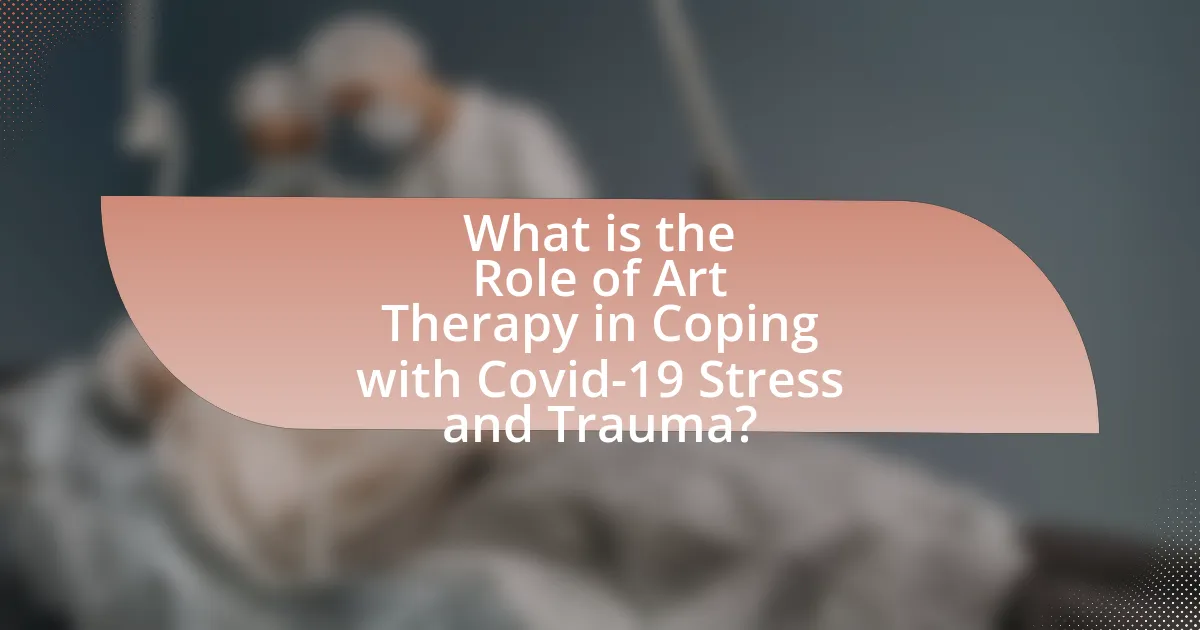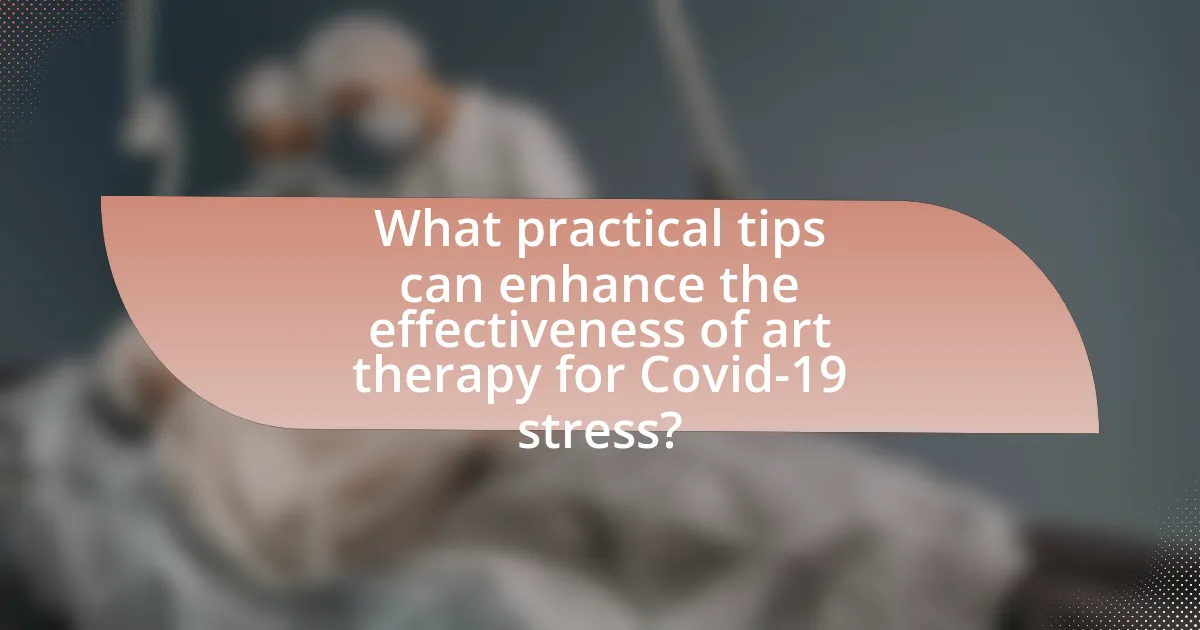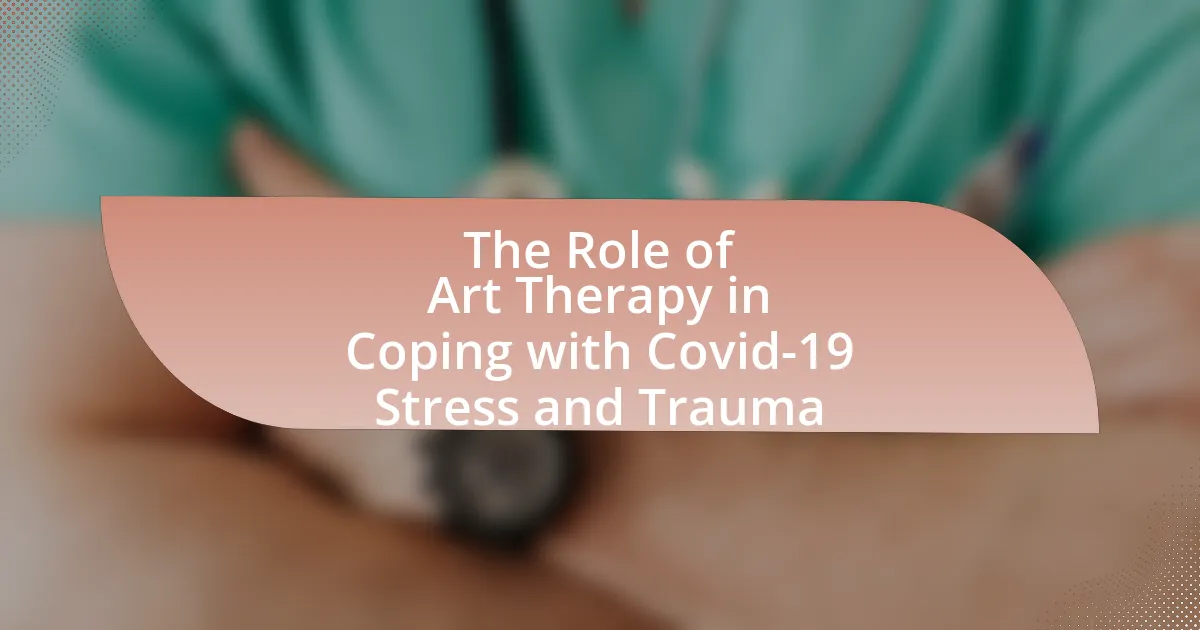Art therapy serves a crucial role in helping individuals cope with stress and trauma related to the Covid-19 pandemic by providing a creative outlet for emotional expression. This therapeutic approach has been shown to reduce symptoms of anxiety and depression, facilitating emotional processing through techniques such as expressive drawing, guided imagery, and collage-making. The article explores the effectiveness of art therapy in addressing the unique mental health challenges posed by the pandemic, including increased feelings of isolation and uncertainty, while also discussing the accessibility of art therapy services and the barriers individuals may face in seeking help. Additionally, it highlights the integration of art therapy with traditional psychological treatments and offers practical tips for incorporating art therapy techniques into daily life to enhance emotional well-being.

What is the Role of Art Therapy in Coping with Covid-19 Stress and Trauma?
Art therapy plays a significant role in coping with Covid-19 stress and trauma by providing individuals with a creative outlet to express their emotions and experiences. This therapeutic approach facilitates emotional processing, allowing participants to visualize and articulate feelings that may be difficult to verbalize. Research indicates that art therapy can reduce anxiety and depression symptoms, which have surged during the pandemic. For instance, a study published in the Journal of the American Art Therapy Association found that art therapy significantly improved emotional well-being among participants dealing with pandemic-related stress. By engaging in artistic activities, individuals can foster resilience, enhance coping strategies, and promote mental health recovery during challenging times.
How does art therapy help individuals cope with stress and trauma during the pandemic?
Art therapy helps individuals cope with stress and trauma during the pandemic by providing a creative outlet for expression and processing emotions. This therapeutic approach allows individuals to communicate feelings that may be difficult to articulate verbally, facilitating emotional release and reducing anxiety. Research indicates that engaging in art-making can lower cortisol levels, a biological marker of stress, thereby promoting relaxation and emotional well-being. A study published in the Journal of the American Art Therapy Association found that participants reported significant reductions in symptoms of anxiety and depression after engaging in art therapy sessions during the pandemic.
What specific techniques are used in art therapy for Covid-19 related stress?
Art therapy for Covid-19 related stress employs specific techniques such as expressive drawing, guided imagery, and collage-making. Expressive drawing allows individuals to visually communicate their feelings about the pandemic, facilitating emotional release and processing. Guided imagery involves using visualization to create calming mental images, helping to reduce anxiety and promote relaxation. Collage-making encourages participants to gather images and words that resonate with their experiences, fostering self-reflection and insight. These techniques have been shown to enhance emotional well-being and coping strategies during stressful times, as evidenced by studies highlighting the therapeutic benefits of creative expression in mental health contexts.
How does the creative process facilitate emotional expression in therapy?
The creative process facilitates emotional expression in therapy by providing individuals with alternative means to articulate feelings that may be difficult to verbalize. Engaging in creative activities, such as drawing or painting, allows clients to explore and express complex emotions in a non-threatening environment. Research indicates that art therapy can reduce anxiety and improve emotional regulation, as evidenced by a study published in the Journal of the American Art Therapy Association, which found that participants reported significant decreases in distress after engaging in art-making activities. This demonstrates that the creative process serves as a valuable tool for emotional expression and healing in therapeutic settings.
Why is art therapy particularly relevant during the Covid-19 pandemic?
Art therapy is particularly relevant during the Covid-19 pandemic because it provides a safe outlet for individuals to express their emotions and cope with stress and trauma. The pandemic has led to increased feelings of anxiety, isolation, and uncertainty, making emotional expression crucial for mental health. Research indicates that creative activities, such as those involved in art therapy, can significantly reduce symptoms of anxiety and depression. For instance, a study published in the Journal of the American Art Therapy Association found that art therapy effectively alleviated psychological distress among participants during the pandemic, highlighting its importance as a therapeutic tool in times of crisis.
What unique challenges does the pandemic pose to mental health?
The pandemic poses unique challenges to mental health, including increased anxiety, depression, and social isolation. Research indicates that the fear of illness, uncertainty about the future, and disruptions to daily life have significantly heightened stress levels among individuals. A study published in the journal “Psychological Medicine” found that 36% of respondents reported experiencing anxiety and 32% reported depressive symptoms during the pandemic, highlighting the widespread impact on mental well-being. Additionally, social distancing measures have led to reduced social interactions, exacerbating feelings of loneliness and isolation, which are critical factors in mental health deterioration.
How does art therapy address these challenges effectively?
Art therapy effectively addresses challenges related to Covid-19 stress and trauma by providing a non-verbal outlet for expression, which can facilitate emotional processing and healing. This therapeutic approach allows individuals to communicate feelings and experiences that may be difficult to articulate verbally, thereby reducing anxiety and promoting mental well-being. Research indicates that engaging in creative activities can lower cortisol levels, a stress hormone, and enhance mood, which is particularly beneficial during times of crisis. For instance, a study published in the Journal of the American Art Therapy Association found that art therapy significantly improved emotional resilience and coping strategies among participants dealing with trauma.
What are the key benefits of art therapy for those affected by Covid-19?
Art therapy provides several key benefits for individuals affected by Covid-19, including emotional expression, stress reduction, and improved mental health. Through creative processes, individuals can articulate feelings of anxiety, grief, and isolation that may arise from the pandemic. Research indicates that engaging in art therapy can lower cortisol levels, a hormone associated with stress, thereby promoting relaxation and emotional well-being. Additionally, a study published in the Journal of the American Art Therapy Association found that art therapy significantly improved symptoms of depression and anxiety in participants during the pandemic, highlighting its effectiveness as a therapeutic intervention.
How does art therapy improve emotional well-being?
Art therapy improves emotional well-being by providing individuals with a creative outlet to express and process their feelings. This therapeutic approach facilitates emotional release, reduces anxiety, and enhances self-awareness through artistic expression. Research indicates that engaging in art therapy can lead to significant reductions in symptoms of depression and anxiety, as evidenced by a study published in the Journal of the American Art Therapy Association, which found that 75% of participants reported improved emotional states after art therapy sessions. Additionally, art therapy fosters a sense of community and connection, which is particularly beneficial for individuals coping with the isolation and stress associated with events like the Covid-19 pandemic.
What evidence supports the effectiveness of art therapy in trauma recovery?
Art therapy has been shown to be effective in trauma recovery through various studies that highlight its impact on emotional expression and psychological healing. For instance, a meta-analysis published in the Journal of Affective Disorders found that art therapy significantly reduces symptoms of anxiety and depression in trauma survivors, with effect sizes indicating moderate to large improvements. Additionally, research conducted by the American Art Therapy Association demonstrates that art therapy facilitates non-verbal communication, allowing individuals to process traumatic experiences more effectively. These findings underscore the therapeutic benefits of art therapy in helping individuals cope with trauma, particularly in the context of stress related to events like the Covid-19 pandemic.
How can individuals access art therapy during and after the pandemic?
Individuals can access art therapy during and after the pandemic through online platforms, local community centers, and licensed therapists. Many art therapists have transitioned to virtual sessions, allowing individuals to participate from home, which has increased accessibility. According to a study published in the Journal of the American Art Therapy Association, online art therapy has proven effective in reducing anxiety and improving emotional well-being during the pandemic. Additionally, community centers often offer workshops or group sessions, which can be found through local health departments or mental health organizations.
What are the different formats of art therapy available (in-person, online)?
Art therapy is available in two primary formats: in-person and online. In-person art therapy involves face-to-face sessions with a licensed art therapist, allowing for direct interaction and immediate feedback. Online art therapy, on the other hand, utilizes digital platforms to conduct sessions remotely, providing flexibility and accessibility for individuals who may not be able to attend in-person sessions. Both formats have been shown to effectively support individuals in coping with stress and trauma, particularly during the Covid-19 pandemic, as they offer creative outlets for expression and emotional processing.
How can one find a qualified art therapist?
To find a qualified art therapist, one should start by searching through professional directories such as the American Art Therapy Association or the British Association of Art Therapists, which list certified practitioners. These directories provide information on therapists’ qualifications, areas of expertise, and contact details. Additionally, checking local mental health clinics or hospitals can yield referrals to licensed art therapists who specialize in trauma and stress-related issues, particularly relevant in the context of coping with Covid-19 stress and trauma.

What are the challenges and limitations of art therapy in this context?
Art therapy faces several challenges and limitations in the context of coping with Covid-19 stress and trauma. One significant challenge is the lack of access to trained art therapists, which can hinder the effectiveness of therapy for individuals in need. According to a study published in the Journal of the American Art Therapy Association, many communities experienced a shortage of mental health resources during the pandemic, limiting the availability of art therapy services. Additionally, the virtual delivery of art therapy can pose difficulties, as not all individuals have the necessary technology or skills to engage effectively in online sessions. Furthermore, the subjective nature of art interpretation can lead to varying outcomes, making it challenging to measure the effectiveness of art therapy quantitatively. These factors collectively limit the reach and impact of art therapy in addressing the psychological effects of Covid-19.
What barriers might individuals face in accessing art therapy?
Individuals may face several barriers in accessing art therapy, including financial constraints, lack of awareness, and limited availability of qualified therapists. Financial constraints can prevent individuals from affording therapy sessions, as many art therapists operate on a fee-for-service basis, which can be prohibitive for low-income populations. Lack of awareness about the benefits and availability of art therapy can lead to underutilization, as individuals may not know that such services exist or how they can help with stress and trauma. Additionally, limited availability of qualified art therapists, particularly in rural or underserved areas, can restrict access to these therapeutic services, making it difficult for individuals to receive the support they need.
How do socioeconomic factors influence access to art therapy?
Socioeconomic factors significantly influence access to art therapy by determining individuals’ financial resources, education levels, and social support systems. Individuals from lower socioeconomic backgrounds often face barriers such as high costs of therapy, lack of insurance coverage, and limited availability of services in their communities. For instance, a study published in the Journal of Art Therapy found that individuals with higher income levels were more likely to engage in therapeutic art practices, highlighting the disparity in access based on economic status. Additionally, educational attainment can affect awareness and understanding of art therapy’s benefits, further impacting access. Thus, socioeconomic status directly correlates with the ability to seek and receive art therapy services.
What misconceptions exist about art therapy that may hinder participation?
Misconceptions about art therapy that may hinder participation include the belief that it is only for individuals with artistic talent or that it is merely a recreational activity. Many people assume that art therapy requires advanced artistic skills, which deters those who do not consider themselves “artists” from participating. Additionally, some view art therapy as less legitimate than traditional forms of therapy, underestimating its psychological benefits. Research indicates that art therapy can effectively reduce symptoms of anxiety and depression, as demonstrated in studies published in the Journal of the American Art Therapy Association, which highlight its efficacy in addressing emotional distress. These misconceptions can prevent individuals from accessing valuable therapeutic resources during challenging times, such as the Covid-19 pandemic.
How can art therapy be integrated with other therapeutic approaches?
Art therapy can be integrated with other therapeutic approaches by combining it with cognitive-behavioral therapy (CBT) to enhance emotional expression and cognitive restructuring. This integration allows clients to explore their feelings through creative processes while simultaneously addressing negative thought patterns, which is particularly beneficial for individuals coping with stress and trauma related to Covid-19. Research indicates that such multimodal approaches can lead to improved outcomes, as evidenced by a study published in the Journal of Clinical Psychology, which found that participants who engaged in art therapy alongside traditional talk therapy reported greater reductions in anxiety and depression symptoms.
What are the benefits of a multidisciplinary approach to trauma recovery?
A multidisciplinary approach to trauma recovery enhances treatment effectiveness by integrating diverse therapeutic modalities, which address the complex nature of trauma. This approach allows for the combination of psychological, medical, and holistic therapies, catering to the varied needs of individuals. Research indicates that such integration can lead to improved emotional regulation, reduced symptoms of PTSD, and enhanced coping strategies. For instance, a study published in the Journal of Traumatic Stress found that patients receiving multidisciplinary care reported significantly better outcomes in mental health and overall well-being compared to those receiving a single type of therapy. This evidence underscores the value of a comprehensive strategy in facilitating recovery from trauma.
How can art therapy complement traditional psychological treatments?
Art therapy can complement traditional psychological treatments by providing a non-verbal outlet for expression, which can enhance emotional processing and facilitate communication of feelings that may be difficult to articulate. This therapeutic approach allows individuals to explore their emotions through creative activities, thereby reducing anxiety and improving overall mental health. Research indicates that art therapy can lead to significant reductions in symptoms of depression and anxiety, as evidenced by a study published in the Journal of the American Art Therapy Association, which found that participants experienced improved emotional well-being after engaging in art therapy sessions. By integrating art therapy with conventional methods, practitioners can offer a more holistic treatment plan that addresses both emotional and psychological needs, particularly in the context of stress and trauma related to events like the Covid-19 pandemic.

What practical tips can enhance the effectiveness of art therapy for Covid-19 stress?
Practical tips to enhance the effectiveness of art therapy for Covid-19 stress include creating a safe and comfortable environment, encouraging self-expression without judgment, and incorporating diverse art materials. A safe space allows individuals to feel secure, which is crucial for emotional exploration. Self-expression fosters personal insight and emotional release, essential for processing stress. Utilizing various art materials, such as paints, clay, or digital tools, can stimulate creativity and engagement, making the therapeutic process more enjoyable and effective. Research indicates that engaging in creative activities can significantly reduce anxiety and improve overall mental health, supporting the efficacy of these tips in art therapy settings.
How can individuals incorporate art therapy techniques into their daily lives?
Individuals can incorporate art therapy techniques into their daily lives by engaging in creative activities such as drawing, painting, or journaling to express emotions and process experiences. These activities can serve as a therapeutic outlet, helping to alleviate stress and anxiety associated with Covid-19. Research indicates that art therapy can enhance emotional well-being and reduce symptoms of trauma, as evidenced by a study published in the Journal of the American Art Therapy Association, which found that participants reported decreased anxiety and improved mood after engaging in art-making activities. By dedicating time each day to these creative practices, individuals can effectively utilize art therapy techniques to cope with the psychological impacts of the pandemic.
What simple art activities can be done at home to relieve stress?
Simple art activities that can be done at home to relieve stress include drawing, painting, coloring, and crafting. Engaging in these activities allows individuals to express emotions creatively, which has been shown to reduce anxiety and improve mood. Research indicates that art therapy can lower cortisol levels, a hormone associated with stress, thereby promoting relaxation and emotional well-being. For example, a study published in the Journal of the American Art Therapy Association found that participants who engaged in art-making reported significant reductions in stress levels.
How can one create a conducive environment for art therapy practice?
To create a conducive environment for art therapy practice, one should ensure a safe, comfortable, and inspiring space that encourages creativity and expression. This involves providing adequate lighting, comfortable seating, and access to various art materials, which can enhance the therapeutic experience. Research indicates that a well-designed environment can significantly impact the effectiveness of therapy; for instance, a study published in the Journal of Art Therapy found that participants reported higher levels of comfort and engagement in spaces that were aesthetically pleasing and well-organized. Additionally, minimizing distractions and incorporating elements of nature can further promote relaxation and focus, essential for effective art therapy sessions.


